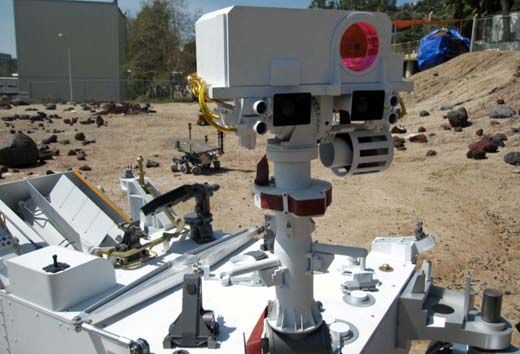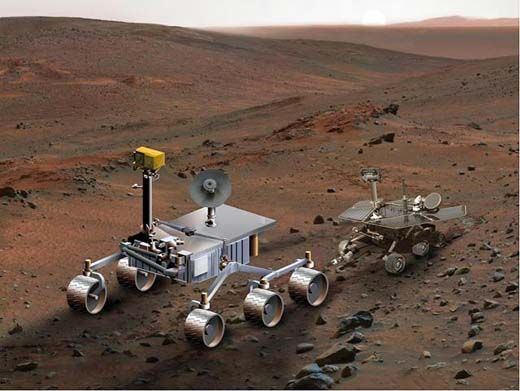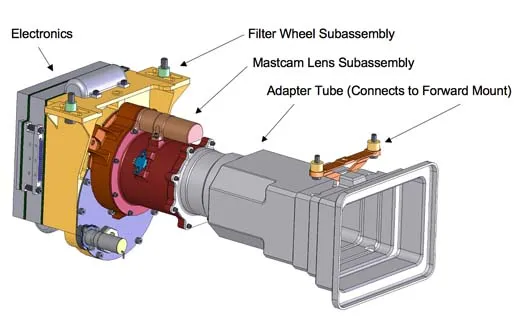Cameron’s Camera
Avatar’s creator hopes to direct the first movies shot on Mars.
/https://tf-cmsv2-smithsonianmag-media.s3.amazonaws.com/filer/mastcam%20from%20photosynth-flash.jpg)
The day after he won two Golden Globes for making the top-grossing film of all time, Avatar director James Cameron was in the NASA Administrator’s office, describing the scene he’d really like to shoot:
“The camera is looking down at the Mars rover,” recalls Mike Ravine, who was in the meeting. “You can see the sample arm off to one side, and we pan up and see Mars in front of us. We’re rolling slowly along the surface. We pan back slowly so we see Mars going by, then look back at the tracks of the rover going off to the horizon behind us—in 3-D.”
As Cameron talked, Ravine looked around at the faces of the gathered NASA officials, “and everybody in the room was nodding, clearly thinking, “Oh, yeah.”
Now the developers of the Mastcam camera for the Mars Science Laboratory (MSL), NASA’s next Mars rover, are trying to make Cameron’s dream come true. They’re in a race to build a zoom 3-D camera—the kind NASA originally selected for the mission, then scrapped as a cost-cutting measure—in time for its October 2011 launch. Actually, the camera needs to be finished by this December, in time to be tested on the rover. Ravine, Advanced Projects Manager at Malin Space Science Systems, the San Diego-based company building the camera, says it’s doable, but just barely. “The first thing I think of when I wake up every morning is, ‘Oh my god, I wish we had more time.’ ”
Restoring the zoom capability would allow the camera to take wide-angle, 3-D video from a perspective comparable to what a person would see walking around Mars. Cameron is included as a co-investigator for Mastcam, which is unusual for a non-scientist. Michael Malin, the camera's principal investigator, invited him to join the project in 2003. Malin knew Cameron through Ravine, who had worked with the director on earlier plans for a commercial moon mission called BlastOff!—forerunner to today’s Google Lunar X-Prize (which Cameron also has an interest in). The director, whose credits include Titanic, the second-highest grossing film ever, has a long association with the real space program, having served on NASA’s Advisory Board and lobbied—unsuccessfully—to fly cameras on the space station.
As a Mastcam co-investigator, he was on track to direct the first movie scenes shot on another planet. Then the MSL, which is larger and more complex than the Spirit and Opportunity rovers now on Mars, ran into money problems. The project’s price tag rose from $1.64 billion to $2.3 billion, and when the costs seemed out of control in 2007, NASA insisted on cuts, one of which was replacing the binocular zoom Mastcam with a simpler instrument that has two “eyes” of fixed, but different, focal lengths. The “descoping” of Mastcam saved about $1.5 million. When work stopped on the zoom version, Ravine figures the camera was about 80 percent complete.
He and his colleagues heaved a sigh and went to work finishing the scaled-down camera, which they recently delivered to the Jet Propulsion Laboratory in California, NASA’s center in charge of the MSL. But they preserved the option of building a zoom camera by going ahead with the purchase of critical camera parts, including small motors used for the zoom assembly, just in case circumstances changed. And when, in 2008, NASA slipped the MSL launch date two years to 2011, they saw an opportunity.
At the time, Cameron was immersed in making Avatar. But in January of this year, he and Ravine met with NASA Administrator Charles Bolden and other agency officials to make their case for replacing the fixed-focus Mastcam with the original zoom version. There is little risk to NASA. The fixed Mastcam is already built and delivered, and will fly on MSL as planned if the zoom version doesn’t come together in time. But if it does, and if it passes qualification tests without holding up the MSL schedule, it could be swapped onto the rover. The plan has passed preliminary technical reviews, and NASA is paying $5 million to construct the zoom camera, which would cost another $2 million to $3 million to install. “Nobody has promised anything,” says Ravine, but the space agency is “supportive and enthusiastic.”
Ravine says that if the zooming camera flies, there would be only a marginal improvement in Mastcam’s science capabilities, but the cinematic advantage would be great. The cameras on Spirit and Opportunity can’t take images fast enough to produce video. The fixed Mastcams on MSL will have that ability, but only for a small field of view. The zoom would give the public a wide-angle, you-are-there view of Mars exploration.
Cameron, who has filmed with 3-D cameras miles underwater, has said his goal in becoming a co-investigator on Mastcam “was to have the same capability on Mars as I have with the 3-D high definition motion imaging system I developed for deep ocean exploration and motion pictures…And that will allow all of us to accompany the rover on its journey.”
That’s also what motivates Ravine, a planetary geologist by training. He agrees with the NASA project manager who said, after a review of the plan to upgrade Mastcam, “I want my grandkids to be able to see this stuff.”


